As promised, this month we’re continuing our discussion of play, focusing on how to use healthy play as an effective training tool. For the October Behavior of the Month, we reviewed how to recognize common characteristics of healthy play and how to use those observations to determine if an interaction is healthy and playful or uncomfortable and potentially dangerous. The common pro-social behaviors that we outlined included play bows (these are especially common with unfamiliar playmates); pauses; exaggerated and lateral movements; open mouths (part of what is often called play face); low loose tails; and self-handicapping (toning down the intensity and style of play).
Now that you’ve had a chance to observe these behaviors in your own dogs, we want to describe how to use appropriate play as a training tool. During Doggy Business play groups we use play as reinforcement in several ways. The first is to teach dogs successful ways of interacting with members of their own species. Proper socialization provides dogs with outlets to interact with other dogs in ways that reinforce appropriate species-specific behaviors (including greetings and pro-social interactions), gives dogs an opportunity for physical exercise and mental stimulation, and decreases stress. The end result is a healthier, happier dog that can greet and interact with other dogs without causing undue stress, anxiety, or aggression.
We also use continued access to social interaction and play as reinforcement for basic skills such as coming when called. Often when we use play and social interaction as reinforcement for basic manners we are exploiting the Premack Principle. This principle is discussed in detail by Leslie McDevitt in her book, Control Unleashed. According to McDevitt, this principle states that, “what the dog wants to do, can be used to reinforce what you want the dog to do.” A common example for humans is – eat your veggies and then you can have your desert! For the dogs in our play groups, we often interrupt play by calling the dog to us, having them sit, and then saying “go play.” They get to run back into the group and continue play.
This routine results in two great consequences. First, encouraging a dog to return to play after coming to you will reinforce the recall (coming to us), therefore making the recall even more likely to happen the next time we call the dog. Second, interrupting play to get a dog’s attention and then allowing the dog to return to play reinforces the behaviors the dog was engaging in before the interruption occurred. In other words, interrupting polite play between two dogs and then letting the dogs return to play reinforces their polite play behaviors, as well as reinforcing the orientation and attention to the trainer. Awesome! It is an amazingly effective technique to teach dogs that tuning into us actually results in getting to do the things they want to do more often.


